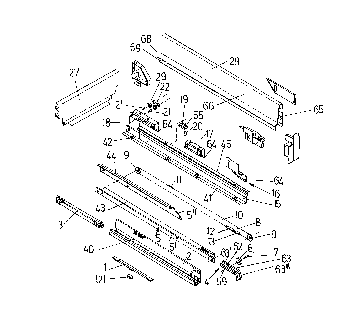Some of the information on this Web page has been provided by external sources. The Government of Canada is not responsible for the accuracy, reliability or currency of the information supplied by external sources. Users wishing to rely upon this information should consult directly with the source of the information. Content provided by external sources is not subject to official languages, privacy and accessibility requirements.
Any discrepancies in the text and image of the Claims and Abstract are due to differing posting times. Text of the Claims and Abstract are posted:
| (12) Patent: | (11) CA 2140211 |
|---|---|
| (54) English Title: | A GUIDE RAIL ASSEMBLY FOR DRAWERS |
| (54) French Title: | GLISSIERE DE TIROIR |
| Status: | Expired and beyond the Period of Reversal |
| (51) International Patent Classification (IPC): |
|
|---|---|
| (72) Inventors : |
|
| (73) Owners : |
|
| (71) Applicants : |
|
| (74) Agent: | MARKS & CLERK |
| (74) Associate agent: | |
| (45) Issued: | 1999-08-31 |
| (22) Filed Date: | 1995-01-13 |
| (41) Open to Public Inspection: | 1995-07-18 |
| Examination requested: | 1995-12-20 |
| Availability of licence: | N/A |
| Dedicated to the Public: | N/A |
| (25) Language of filing: | English |
| Patent Cooperation Treaty (PCT): | No |
|---|
| (30) Application Priority Data: | ||||||
|---|---|---|---|---|---|---|
|
A guide pail assembly for drawers, having a support
rail (2) fastenable to a furniture body a pull-out rail
(15) fastenable to the drawer and a middle rail (5) disposed
between the support rail and the pull-out rail on either side
of the drawer. The weight of the drawers is transmitted
between the rails (2, 5, 15) by means of track rollers (6, 22,
23). A respective deflection roller (9) for a control rope
(10) is disposed at the front and the rear end of the middle
rail (5). Disposed at the front end of the middle rail (5) is
an end bearer (4) made of plastic material, which at the front
has a curved, downwardly directed cap (14) for the front end
of the rail (5).
Note: Claims are shown in the official language in which they were submitted.
Note: Descriptions are shown in the official language in which they were submitted.

2024-08-01:As part of the Next Generation Patents (NGP) transition, the Canadian Patents Database (CPD) now contains a more detailed Event History, which replicates the Event Log of our new back-office solution.
Please note that "Inactive:" events refers to events no longer in use in our new back-office solution.
For a clearer understanding of the status of the application/patent presented on this page, the site Disclaimer , as well as the definitions for Patent , Event History , Maintenance Fee and Payment History should be consulted.
| Description | Date |
|---|---|
| Inactive: IPC expired | 2017-01-01 |
| Inactive: IPC expired | 2017-01-01 |
| Inactive: IPC from MCD | 2006-03-11 |
| Time Limit for Reversal Expired | 2004-01-13 |
| Letter Sent | 2003-01-13 |
| Grant by Issuance | 1999-08-31 |
| Inactive: Cover page published | 1999-08-30 |
| Pre-grant | 1999-05-21 |
| Inactive: Final fee received | 1999-05-21 |
| Amendment Received - Voluntary Amendment | 1999-03-25 |
| Letter Sent | 1999-03-12 |
| Notice of Allowance is Issued | 1999-03-12 |
| Notice of Allowance is Issued | 1999-03-12 |
| Inactive: Approved for allowance (AFA) | 1998-07-14 |
| Inactive: Application prosecuted on TS as of Log entry date | 1997-12-11 |
| Inactive: Status info is complete as of Log entry date | 1997-12-11 |
| All Requirements for Examination Determined Compliant | 1995-12-20 |
| Request for Examination Requirements Determined Compliant | 1995-12-20 |
| Application Published (Open to Public Inspection) | 1995-07-18 |
There is no abandonment history.
The last payment was received on 1998-12-29
Note : If the full payment has not been received on or before the date indicated, a further fee may be required which may be one of the following
Patent fees are adjusted on the 1st of January every year. The amounts above are the current amounts if received by December 31 of the current year.
Please refer to the CIPO
Patent Fees
web page to see all current fee amounts.
| Fee Type | Anniversary Year | Due Date | Paid Date |
|---|---|---|---|
| Request for examination - standard | 1995-12-20 | ||
| MF (application, 3rd anniv.) - standard | 03 | 1998-01-20 | 1998-01-07 |
| MF (application, 4th anniv.) - standard | 04 | 1999-01-13 | 1998-12-29 |
| Final fee - standard | 1999-05-21 | ||
| MF (patent, 5th anniv.) - standard | 2000-01-13 | 1999-12-21 | |
| MF (patent, 6th anniv.) - standard | 2001-01-15 | 2000-12-28 | |
| MF (patent, 7th anniv.) - standard | 2002-01-14 | 2001-12-20 |
Note: Records showing the ownership history in alphabetical order.
| Current Owners on Record |
|---|
| JULIUS BLUM GESELLSCHAFT M.B.H. |
| Past Owners on Record |
|---|
| HERMANN HAMMERLE |
| INGO GASSER |